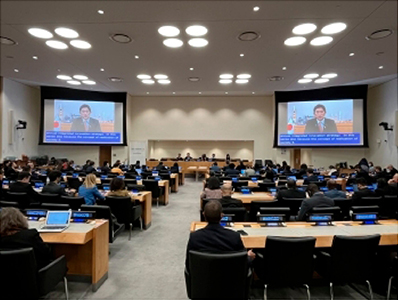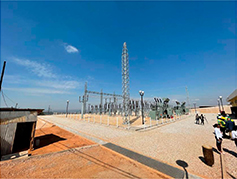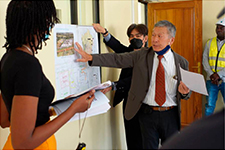(10) Science, Technology, and Innovation (STI) for SDGs
In the world today, social changes occur and information and communication technology (ICT), artificial intelligence (AI), and robotics are utilized in diverse industries, including not only the manufacturing industry and the service industry but also agriculture and construction.
Based on the 2030 Agenda for Sustainable Development (Paragraph 70), the UN has established the UN Inter-agency Task Team on STI for the SDGs (UN-IATT) and promotes Science, Technology, and Innovation for SDGs (STI for SDGs) on a global scale, in cooperation with countries. The UN Multi-Stakeholder Forum on Science, Technology, and Innovation for the Sustainable Development Goals (STI Forum) was held again in 2022. Expectations for STI are internationally increasing as a key to achieve the SDGs while optimizing limited resources.
● Japan’s Efforts

7th STI Forum held at the UN Headquarters (May 2022)
In the process of Japan’s economic development, Japan has overcome its own challenges in fields such as health and medical care, environment, and disaster risk reduction, fully utilizing STI. Based on these experiences, Japan is engaged in science and technology cooperation through the “Science and Technology Research Partnership for Sustainable Development (SATREPS) program” Note 85 and others in order to resolve challenges faced by developing countries. The development of a sustainable land management framework to combat desertification in Ethiopia is a good example from SATREPS that contributes to resolving challenges in developing countries.
The UN-IATT conducts the “Global Pilot Programme” in six pilot countries, India, Ukraine (since 2021), Serbia, Ethiopia, Ghana, and Kenya, in order to promote the formulation of STI for SDGs Roadmaps across the world. Under this Programme, Japan has provided assistance to Kenya in the agricultural sector since FY2020 through its contributions to the World Bank. In addition, through contributions to the United Nations Development Programme (UNDP), Japan has continued to support Japanese companies that consider launching projects to resolve social challenges in developing countries through STI since FY2020.
Rwanda
Contributing to Stable Supply of Energy through Long-Term Support
The Project for Improvement of Substations and Distribution Network Phase 3
Grant Aid (September 2018 - August 2023)
In Kigali, the capital of Rwanda, demand for electricity has increased due to rapid urbanization and population growth in recent years. However, the shortage of power supply facilities caused the overloading of the main substations in the city. Therefore, the power supply of the city has been unstable, and has affected the economic activities of Kigali and the living condition of citizens.
In response to the situation, since 2011, Japan has been providing assistance for ensuring the stable and efficient supply of electricity. The assistance includes maintenance of facilities such as substations and power distribution networks through grant aid, as well as technical cooperation, such as improving the capacity of the public electric power corporation to develop efficient power systems and facility maintenance and management.
Under the grant aid project titled the “Project for Improvement of Substations and Distribution Network Phase 3,” as a response to the growing demand, a new substation was built and approximately 20 km of distribution lines were installed in Kigali to ameliorate the overloaded state of major substations in the city. The new distribution lines, which are laid in parallel with the existing ones, enable the prevention of power outages even if one of the distribution lines breaks or if there is a sudden increase in power demand in one area.
In this way, Japan’s long-term assistance has greatly contributed to the stable supply of electricity to 1.2 million residents in the city, and thus the development of Kigali’s economic infrastructure and the improvement of the living environment for its citizens.

New Gasogi substation and distribution line

Mr. Uruno, a consultant, explaining how substations and distribution lines work (Photo: Yachiyo Engineering Co., Ltd.)
- Note 85: See the glossary.
